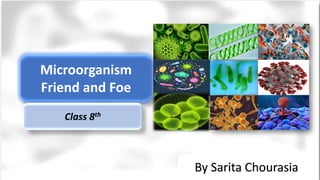
Microorganisms: Friend and Foe
- 1. By Sarita Chourasia Microorganism Friend and Foe Class 8th
- 3. Sarita C Definition Organism that can be seen only under the microscope are called microorganisms which may exist in its single-celled form or a colony of cells The study of microorganisms is called Microbiology
- 4. Sarita C Classification Microorganisms Algae Viruses Protozoans Fungi Bacteria
- 5. Sarita C Algae (singular - Alga) • A plantlike organism • Vary a lot in shape, size, and habitat • Have chlorophyll (can photosynthesize) • Reproduce sexually and asexually • Found in different color brown, red, green, blue-green sargassum Asparagopsis texiformis Chlorophyta •Euglenophyta (euglenoids) ... •Cryptophyta (golden-brown algae) ... •Pyrrophyta (fire algae) ... •Chlorophyta (green algae) ... •Rhodophyta (red algae) ... •Phaeophyta (brown algae) ... •Xanthophyta (yellow-green algae) Xanthophyta Pyrrophyta Blue-green algae
- 6. Diatom are fascinating group of algae • Unicellular • Have an infinite range of forms • Found in freshwater and marine habitats • Cell wall of silica • Large masses of diatoms floating in the sea are called plankton Diatom Sarita C Glowing plankton
- 7. Sarita C 1. Algin (gummy substance)- thicken ice cream, cosmetics, shaving cream, preparation of medicines, synthetic fiber 2. Agar (jellylike substance) –microorganism and tissues are cultured 3. Diatom shells- to make glass, porcelain, ceramics to make toothpaste, polishes and filters 4. Certain red algae are eaten in China and Japan 5. Greatest providers of oxygens(accounting for 80% of oxygens in the air) 6. Algae produce hydrogen which is a fuel for future 7. It is used in the recycling of waste water from industries Useful algae Eutrophication
- 8. Sarita C Bacteria • Small single-celled organism • Found almost everywhere on Earth and are vital to the planet’s ecosystems • Some species can live under extreme conditions of temperature and pressure • Reproduce asexually by binary fission • Found in four different shapes There are four common forms of bacteria- 1. coccus 2. bacillus 3. spirillum 4. vibrio. Coccus Bacillus Spirillum vibrio
- 9. Sarita C Useful Bacteria • Used to make alcohol and vinegar • Used to make yoghurt and cheese from milk • Used in production of tea, coffee and tobacco • Antibiotics can be formed by some bacteria • In intestine help in the absorption of food • Bacteria are active in the Carbon and Nitrogen Cycles • Great nature’s decomposers • Help to make biogas and compost from waste
- 10. Sarita C Harmful Bacteria • Pathogenic bacteria can cause diseases in humans and animals for example Typhoid, Tetanus, Cholera, Pneumonia, Tuberculosis, Leprosy • Pathogenic bacteria can cause diseases in plant like Wilt and citrus canker • spoil food (Milk turns sour, butter tuns rancid) • Bacteria can cause tooth decay
- 11. Sarita C Fungi (singular-fungus) • A plantlike organism • Unicellular and multicellular • Vary a lot in shape, size • Lack chlorophyll • Saprophytes and parasites There are some 70,000 types of fungi 1. yeast 2. mushroom 3. Moulds 4. Rusts 5. Smuts are fungi
- 12. Sarita C Yeast • Unicellular • Turn sugar into alcohol (by fermentation) • Reproduces by budding • Can live both aerobically and anaerobically The yeast breaks down the sugar in the dough to get energy (anaerobic respiration or fermentation). Carbon dioxide and alcohol are produced in the process. It is the carbon dioxide that makes the dough rise and look bubbly. Sugar alcohol + carbon dioxide Fermentation by yeast
- 13. Sarita C Moulds • Multicellular fungi • Greyish and bluish fuzzy growth on rotting things(ex: bread and oranges) • Grow on starchy food and damp leather • Reproduce by spores (sexually and asexually) sporangium Hypha Mycelium spores Mycelium
- 14. Sarita C Useful fungi • Some mushrooms are edible • Used to make bakery product • Beverage • Biofuel • Used in the preparation of B- complex vitamin • Used to make penicillin and other antibiotics • Used to flavor processed Cheese making • Nature’s decomposers • Research • Pest control • Vegan leather made from mushrooms
- 15. Sarita C Harmful fungi • Plant diseases such as rust, smut, wilt and blight • Human diseases such as ringworm, athlete’s foot, barber’s itch, dhobi’s itch • Food spoiler • mycotoxins
- 16. Sarita C Protozoans • Unicellular organism • Animal-like protists • Some protozoans contains chlorophyll and can photosynthesize • Some are saprophytes or parasites • Reproduce by binary fission
- 17. Sarita C Useful protozoans • Some protozoans live in the body of other organisms and help them(termites have protozoans in their body. The protozoans digest the cellulose in the wood eaten by termites and convert it into carbohydrates that the termites can use ) • ultimate decomposers • Useful in the treatment of sewage • Serve as food for many small aquatic organism
- 18. Sarita C Harmful protozoans • Some protozoans cause diseases • Entamoeba histolytica causes amoebiasis (amoebic dysentery) in human being • Plasmodium cause malaria • Trypanosoma causes sleeping sickness
- 19. Sarita C Viruses • Acellular • All viruses cause diseases • Parasites • They cannot reproduce unless they enter the cell of a living organism
- 20. Sarita C Viruses All viruses cause diseases and are parasites. They can infect plants, animals, and even bacteria. Common cold, influenza, hepatitis, rabies, polio and AIDS ( acquired immune deficiency syndrome) are some viral diseases.